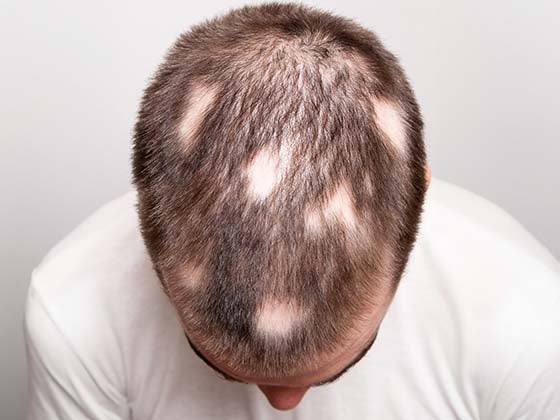Are you one of the many men who struggle with hair loss? If so, you’re not alone. Whether it's a receding hairline, thinning crown or bald spot in the back of your head, male pattern balding is one of the most common types of hair loss in men. It affects about 25% of all males from their adolescence through their golden years. The good news is that there are many treatments available to help you cope with and fight hair loss. Read on to learn about the different stages of male pattern balding and what you can do about it.
What is Male Pattern Baldness?
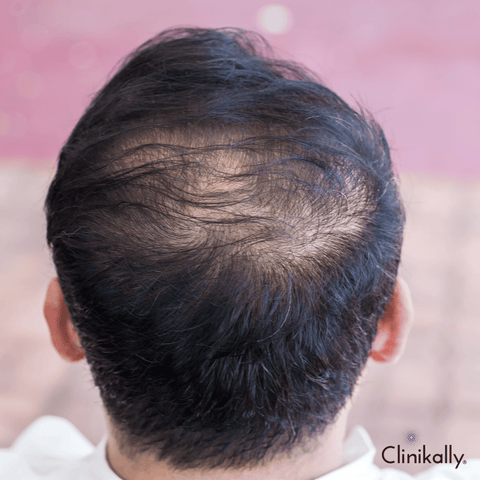
Male pattern baldness is a condition in which men experience gradual hair loss on the crown (top) of their heads. It is most commonly caused by androgenetic alopecia (male pattern baldness), which is the most common type of hair loss. The cause is unknown, but it's believed to be related to hormones and genetics. Male pattern baldness is distinguished by the following characteristics:
-
Gradual Hair Loss: It usually starts with a receding hairline, which often forms a "M" shape where the hairline begins to recede at the temples.
-
Thinning at the Crown: Hair loss progresses to the crown of the head, resulting in thinning or balding.
-
Miniaturisation of Hair Follicles: Miniaturisation occurs when affected hair follicles shrink and produce thinner, shorter hair over time. These hair follicles may eventually cease to produce visible hair.
-
Hormonal Influence: Androgens, in particular dihydrotestosterone (DHT), a hormone derived from testosterone, have an impact on male pattern baldness. Hair follicles in individuals genetically predisposed to male pattern baldness are more sensitive to DHT, which leads to the miniaturization of follicles and eventual hair loss.
-
Genetic Predisposition: Male pattern baldness is significantly influenced by family history. It can be inherited from either the mother or the father and is typically inherited in families.
-
Age-Related Progression: Adulthood is typically the onset of male pattern baldness, which advances gradually over time. People can have different rates and degrees of hair loss.
Male pattern baldness is a non-inflammatory condition that does not often cause scalp itching, pain, or redness. While many men consider it a natural aspect of ageing, changes in look and self-perception can have substantial psychological and emotional consequences. When initiated early in the balding process, treatment options such as minoxidil and finasteride, hair transplant surgery, and other therapies can help manage male pattern baldness by slowing down hair loss or stimulating hair regrowth. Consultation with a dermatologist or other healthcare practitioner who specialises in hair issues can provide significant insights and treatment options depending on individual needs.
There is no known cure for male pattern baldness, but treatments include using dermatologist-recommended shampoos, supplements for hair fall, prescription medications, and even hair restoration surgery. Hair loss treatments are most successful when started early and are tailored to the individual. By understanding the definition and causes of male pattern baldness, you can take the first steps towards improving your cosmetic outcomes.
Stages of Male Pattern Baldness
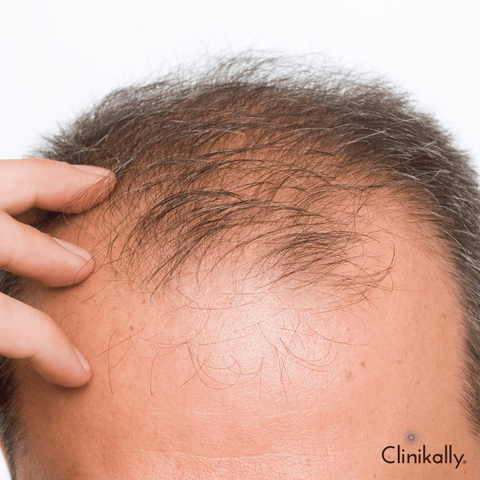
Male pattern balding can be broken into different stages depending on the severity of hair loss. The first stage, known as the “early stage,” involves some thinning at the top of the head and a receding hairline. The “intermediate stage” involves a wider balding area, with more hair lost at the crown. Finally, in the “advanced stage,” there’s significant balding throughout the head. In addition to the type and severity of your balding, you can also track your progress by taking regular photos of your hair loss. This will help you see the extent of your hair loss in a way that’s easy to quantify.
-
Stage 1: Hair thinning starts and is unnoticeable at first
-
Stage 2: Hair thinning progresses and develops into an M-shaped hairline
-
Stage 3: Visible balding which progresses into a U-shaped or V-shaped hairline
-
Stage 4: Hair loss even at the back of the head
Treat and Prevent Male Pattern Baldness
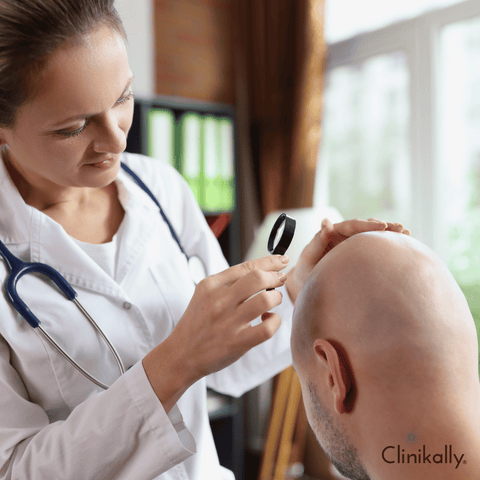
Male pattern baldness is a genetic disorder that affects hair growth on the head and can be treated with medication or surgery. If you are experiencing hair loss, always consult with a qualified doctor to determine the best course of treatment for you. Medications and surgery work to stop hair loss in its early stages by targeting the hormone responsible for balding. Surgery removes areas of balding skin and rebuilds the hair follicles with healthy cells from other parts of your body.
Tackle Male Pattern Baldness with Science!

The sooner you recognize and address male pattern balding, the better. There are many effective treatments for hair loss, and the sooner you start using them, the better your chances of growing new hair. Male pattern balding can be a challenging experience, but you can learn to manage it through healthy hair practices and medical treatments. If you’re suffering from male pattern balding, there are many treatments available to help you cope with and fight hair loss.
Symptoms of Male Pattern Baldness
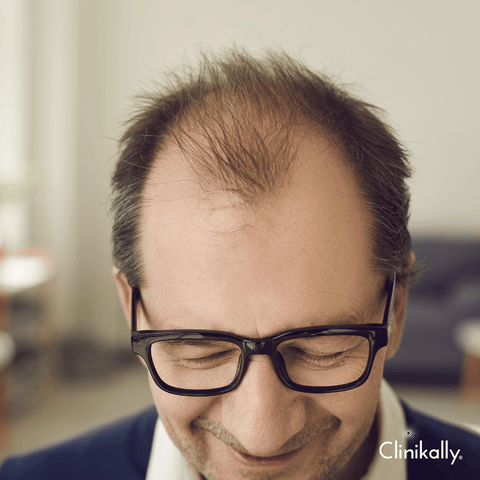
Male pattern baldness is a common hair loss condition that affects around 50-70% of men in their lifetime. If you're concerned about thinning hair on the top of your head, don't panic. Male pattern baldness is a gradual loss of hair on the scalp, and it can start as early as your late 20s or 30s.
These symptoms usually appear gradually and include:
-
Receding Hairline: A receding hairline is one of the primary symptoms of male pattern baldness. Hair loss usually starts at the temples or on the forehead and forms a "M" shape as the hairline recedes backward.
-
Hair Thinning at the Crown: Another distinguishing feature is hair thinning at the crown of the head. The hair at the crown gradually thins out over time, which can result in bald spots or a visible widening of the part.
-
Gradual Hair Thinning: Hair gradually becomes finer, shorter, and less pigmented (thinner and lighter) than surrounding hair. This is due to hair follicle miniaturisation, which results in smaller, weaker hair strands.
-
Male Pattern Baldness: Male pattern baldness progresses slowly over years or even decades. Individuals' hair loss rates can vary, and some may experience more rapid hair loss than others.
-
Increased Scalp Visibility: As hair thins and becomes fewer in number, the scalp becomes more visible, especially in areas where hair loss is prominent, such as the crown and temples.
-
No Associated Scalp Symptoms: Typically, male pattern baldness does not cause any itching, redness, or scarring of the scalp. It is primarily a non-inflammatory condition.
While male pattern baldness follows a specific pattern, the severity and pace of hair loss might differ between people. Other conditions or factors may also contribute to hair loss, thus a complete examination by a dermatologist or healthcare professional is necessary to fully identify male pattern baldness and rule out other possible reasons.
If you're experiencing some of the common symptoms, like hair loss, scalp irritation and thinning hair, it's time to see a qualified doctor for an evaluation and recommendation for treatment options. The cause of male pattern baldness is unknown, but there are a few things that can contribute, like genetics and lifestyle choices. There is no one-size-fits-all treatment for male pattern baldness, but treatments range from Rogaine to hair loss surgery. So whatever the cause, don't stop trying to fight hair loss - there are many options available and the sooner you start treatment, the better the outcome.
Causes of Male Pattern Baldness

Male pattern baldness is a common hair loss condition that affects men in their 30s and 40s. The cause of the condition is unknown, but it's thought to be caused by genetics and hormone levels. The hair loss usually progresses gradually and affects the scalp, crown and hairline. It's important to understand the causes and treatment options for male pattern baldness if you're concerned about your hair loss. There are treatments available that can restore hair growth to affected areas, although the results may not last indefinitely. If you're experiencing hair loss and are worried about the future, talk to your doctor about the best course of action for you.
Male pattern balding happens when the hair follicles on the top of your head, as well as the back of your head, become genetically programmed to shrink and eventually disappear. What causes this to happen? Scientists aren’t exactly sure, but it’s likely a combination of genetics and hormonal changes. The good news is that male pattern balding can be slowed down and even stopped with the right treatment. If you start taking care of your hair now, you can help halt the progression of hair loss and even grow some new hair.
Identifying The Stage of Male Pattern Baldness
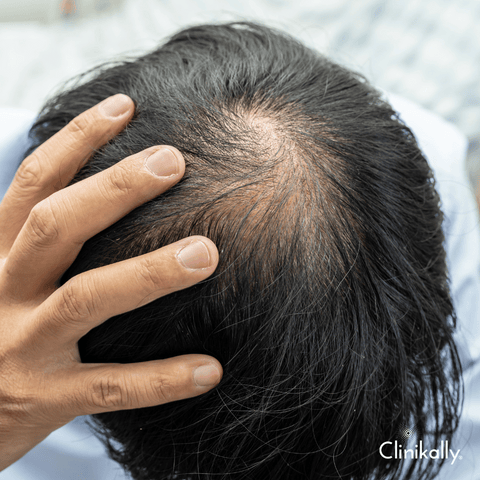
If you’re wondering where you fall on the spectrum of male pattern balding, there are a few factors you’ll want to take into account. First, take a look at your hairline. If your hairline is moving back, you could be experiencing some hair loss. If you notice that the hairline is more than just thinning, you may be in the early stages of male pattern balding. You can also check the area above your ears. If the hair above your ears is noticeably thinning, or if you’re seeing some spots of hair loss, you could be in the early stages of male pattern balding. To know for sure, take note of the amount of hair you have on your scalp. If there’s significantly less hair than you remember, you may be in the early stages of male pattern balding.
Exams & Tests for Male Pattern Baldness

Male pattern baldness is a condition that affects the hair on the crown of the head. It's caused by hormones, genetics and lifestyle choices - so there isn't one "cause." However, there are treatments available that can help hair growth and keep the baldness at bay. Keep in mind that male pattern baldness is not a permanent condition and can be treated over time. Typically, hair growth is slow in the early stages of the baldness and will gradually grow back over time. However, it's important to consult with a hair loss specialist who can recommend the most suitable treatment plan for you and your hair type. There are a number of treatment options available, but they typically require multiple appointments over time to achieve results.
Prevent Male Pattern Baldness at an Early Stage

Male pattern baldness is a condition that affects hair growth on the scalp and is often considered a sign of aging. However, there's no one-size-fits-all approach to treatment. The root cause of male pattern baldness is not known, but it's likely caused by a combination of genetics and environmental factors.
Fortunately, hair fall remedies and treatments can help slow down or even prevent male pattern baldness. The most common treatment is hair transplantation, which can restore hair loss and improve scalp health. Male pattern baldness is a condition that begins gradually, with hair thinning on the top of your head, you can prevent male pattern baldness if you start treatment early.
Clinikally's hair growth serum has been formulated by dermatologists using powerful botanicals like Procapil and AnaGain that increases hair density and reduces hair loss. Spray the serum 5-6 times over the entire scalp evenly. Rub gently with fingers and leave it on for 8-12 hours. Apply twice for best results.
Over time, hair loss can become more noticeable and severe, and hair transplantation may be the only option to restore hair growth and improve scalp health.
Seek Expert Advice from a Dermatologist
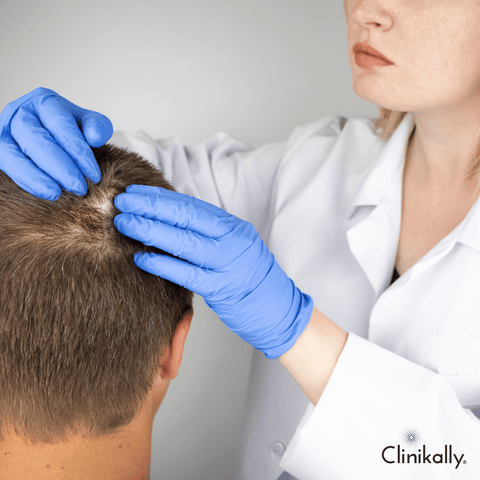
Hair loss can be a troubling and frustrating experience. It's important to know that it is possible to prevent hair loss with early detection and treatment. If you are experiencing hair loss, talk to your dermatologist for advice on how to best manage the situation. They will help you find the most effective treatment options based on your specific hair loss condition and scalp type.
At Clinikally, you can get an online dermatologist consultation where a hair expert will analyse your hair concerns related to male pattern baldness and recommend a personalised treatment plan that will be shipped to your doorstep for free.
Latest Research in Hair Loss and Regrowth
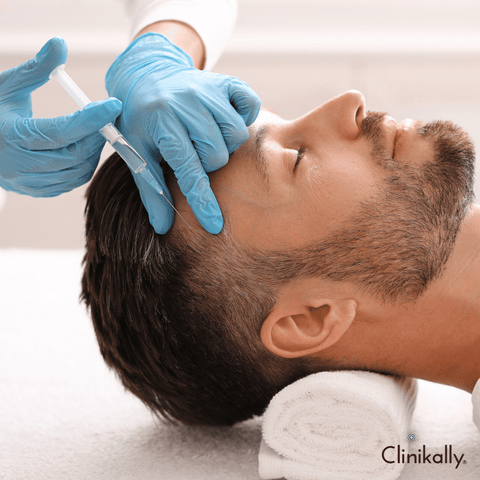
Hair loss and regrowth research has been a quickly expanding subject, with several creative procedures and treatments being explored. Among the most recent study areas are:
-
Stem Cell Therapy: Researchers are looking into the possibility of using stem cells to stimulate hair growth. Stem cells have the ability to differentiate into various cell types, and research has shown promising results in regenerating hair follicles.
-
Platelet-Rich Plasma (PRP) Therapy: PRP therapy entails taking a patient's blood, processing it to concentrate the platelets, and injecting this plasma into the scalp. Recent research suggests that PRP can stimulate hair growth by promoting tissue repair and regeneration.
-
Gene Therapy: Advances in gene therapy are being investigated in order to better understand the genetic factors that contribute to hair loss. Researchers are investigating gene editing techniques and their potential for preventing or reversing hair loss by targeting specific genes associated with hair follicle growth.
-
Nutritional Approaches: Research into the role of nutrition and dietary supplements in promoting hair health continues. Certain vitamins, minerals, and supplements, such as biotin, vitamins D and E, and omega-3 fatty acids, are being researched for their ability to promote hair growth.
-
Topical Treatments: The development of novel topical treatments, such as solutions containing growth factors or peptides, is being researched to encourage hair follicle regeneration and counteract hair loss.
-
Microbiome and Hair Health: Research has emerged exploring the link between the scalp microbiome (the community of microorganisms on the scalp) and hair health. Understanding this relationship could lead to new treatments to improve the scalp environment for better hair growth.
-
Laser Therapy: Low-level laser therapy (LLLT) has gained attention as a non-invasive treatment for hair loss. Studies are ongoing to determine its efficacy in stimulating hair growth by increasing blood flow and cellular activity in the scalp.
-
3D Printing of Hair Follicles: Researchers are investigating 3D printing technology to create hair follicle germs that can be implanted into the scalp, potentially providing a solution for hair loss by generating new follicles.
While there have been major advances and exciting discoveries, not all treatments may work uniformly, and individual reactions to treatments may differ. Consultation with a healthcare practitioner or a dermatologist specialising in hair issues is essential for determining the most appropriate and successful treatment options based on individual circumstances and current research.
The Psychological Impact of Male Pattern Baldness
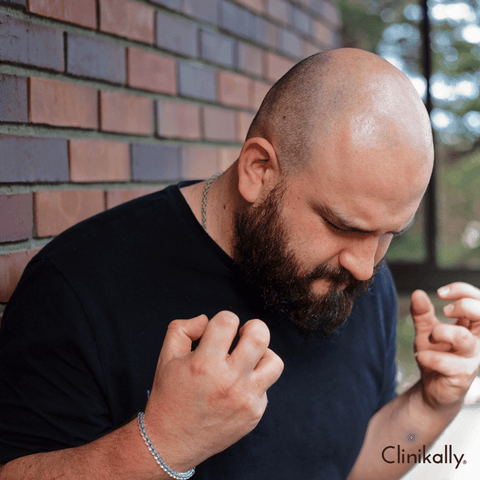
Male pattern baldness, commonly known as androgenetic alopecia, can have serious psychological consequences for those who suffer from it. While it is primarily a medical condition characterised by hair loss, the psychological implications can be significant and varied, affecting self-esteem, body image, and overall mental well-being. Here are some of the psychological consequences of male pattern baldness:
-
Reduced Self-Esteem: Hair loss can have an impact on self-perception and self-worth. Individuals suffering from baldness may feel less attractive, resulting in lower self-esteem and confidence in social situations.
-
Body Image Issues: Balding can cause a person's perception of their physical appearance to change. Those who are affected may feel dissatisfied with their overall appearance and with their body image.
-
Negative Social Perception: A full head of hair is often associated with youthfulness and attractiveness in society. Balding people may believe they are being judged negatively or perceived negatively by others because of their appearance.
-
Anxiety and Depression: The emotional impact of hair loss can lead to increased levels of stress, anxiety, in some cases, depression. Concerns about appearance and worries about social acceptance can contribute to these feelings.
-
Impact on Relationships: Hair loss can have an impact on both personal and professional relationships. Individuals may lack confidence in dating or professional situations, affecting their interactions and relationships with others.
-
Body Dissatisfaction: Balding can cause dissatisfaction with one's body and appearance, potentially leading to individuals avoiding social situations or activities in which their appearance is a focal point.
-
Impact on Lifestyle Choices: Some people may change their hairstyles, clothing, or even avoid certain activities to conceal or distract from their hair loss, thereby affecting their lifestyle and self-expression.
Addressing the Psychological Impact:
-
Support Systems: Having a support system, whether it is friends, family, or support groups, can help you cope with the psychological effects of hair loss.
-
Therapeutic Interventions: Seeking counselling, therapy, or support from mental health professionals can help manage feelings of anxiety, depression, or low self-esteem caused by hair loss.
-
Treatment Options: Investigating various hair loss treatment options, such as medications, hair transplants, or other therapies, can help you regain confidence and improve your self-perception.
-
Self-Acceptance: Accepting one's appearance and focusing on other positive aspects of life can lead to increased self-acceptance and psychological well-being.
While male pattern baldness can have substantial psychological consequences, it is critical to address these concerns early on. Seeking help, researching treatment alternatives, and encouraging self-acceptance are all important stages in dealing with the psychological repercussions of hair loss.
Natural Remedies Vs. Medical Treatments for Hair Loss

Natural remedies and medical treatments are frequently used in the treatment of hair loss. Both methods have pros and cons, and their efficacy varies depending on the underlying cause of hair loss, individual variables, and the severity of the condition. Here's a comparison of natural hair loss cures and medical treatments:
Natural Remedies:
-
Herbal Remedies: Ingredients such as saw palmetto, aloe vera, ginseng, and pumpkin seed oil are thought to have properties that promote or inhibit hair growth. They are frequently available in the form of supplements or topical applications.
-
Essential Oils: When applied to the scalp, essential oils such as rosemary oil, peppermint oil, and lavender oil have been shown to stimulate hair growth. These hair oils may increase circulation and nourish the hair follicles.
-
Nutritional Supplements: Biotin, vitamins (such as B-complex vitamins, vitamin D, and vitamin E), minerals (such as iron and zinc), and omega-3 fatty acids are commonly used as supplements to support hair health and growth.
-
Scalp massage and aromatherapy: It is believed that regular scalp massages and aromatherapy using essential oils increase blood circulation to the scalp, which may aid in promoting hair growth and reducing stress, both of which can contribute to hair loss.
Medical Treatments:
-
Minoxidil (Rogaine): This is an FDA-approved over-the-counter topical medication for hair loss. Minoxidil is known to promote hair growth and prevent further hair loss by extending the growth phase of the hair follicles.
-
Finasteride (Propecia): Finasteride, another FDA-approved medication, is available as a prescription pill to treat male pattern baldness. It works by preventing testosterone from being converted into dihydrotestosterone (DHT), a hormone linked to hair loss.
-
Platelet-Rich Plasma (PRP) Therapy: This medical procedure involves extracting and injecting a concentrated form of the patient's own blood platelets into the scalp in order to stimulate hair growth by encouraging tissue repair and regeneration.
-
Hair Transplant Surgery: Surgical procedures involve transplanting hair follicles from areas of the scalp where hair is abundant to areas of the scalp where hair is thinning or balding. Techniques such as follicular unit transplantation (FUT) or follicular unit extraction (FUE) are commonly used.
Comparison:
-
Effectiveness: In many cases, medical therapies, particularly drugs like minoxidil and finasteride, have been clinically demonstrated to be successful. Natural therapies may have limited scientific data to back up their efficacy.
-
Safety and Side Effects: Natural solutions, on average, have fewer adverse effects than some medical treatments, which may cause scalp irritation, sexual dysfunction (in the case of finasteride), or allergic responses.
-
Regularity and Consistency: To maintain benefits, several medical therapies necessitate daily use or persistent application. Natural therapies may require longer-term application to have apparent results.
While natural solutions can give a more holistic and presumably safer approach to hair loss treatment, medical treatments backed by scientific research frequently produce more predictable and successful outcomes. Consultation with a healthcare practitioner or dermatologist can assist in determining the best treatment options depending on individual needs and the reason for hair loss.
The Role of Genetics in Male Pattern Baldness
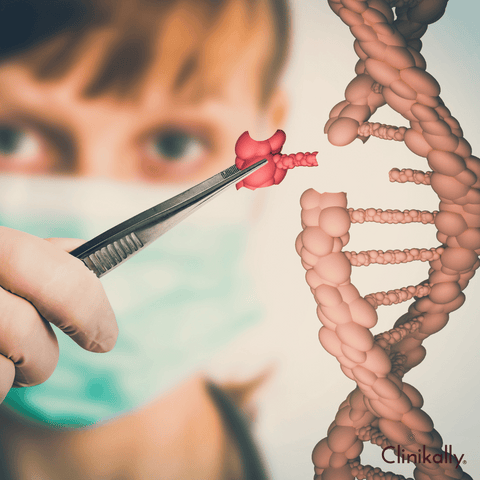
Male pattern baldness, commonly known as androgenetic alopecia, is influenced by genetics. This is the most common cause of male baldness, and it is characterised by a distinct pattern of hair thinning and loss that frequently starts at the temples and crown of the head. Male pattern baldness is inherited through a complex interaction of genetic and hormonal factors:
-
Genetic Predisposition: Genetic susceptibility is the main cause of male pattern baldness. It can be inherited from either parent and is typically inherited in families. The likelihood of experiencing hair loss is influenced by multiple genes, and it is not caused by a single gene.
-
Androgen Receptors and Hormones: Androgens, specifically dihydrotestosterone (DHT), are important in the development of male pattern baldness. DHT is a hormone that is produced from testosterone by an enzyme called 5-alpha-reductase. Hair follicles in men who are genetically predisposed to male pattern baldness are more sensitive to the effects of DHT. DHT binds to androgen receptors on hair follicles, causing miniaturisation, a shortening of the growth phase, and eventually thinner, shorter, and less visible hair.
-
Male Pattern Baldness Inheritance Patterns: The inheritance of male pattern baldness is complicated, with multiple genes from both the maternal and paternal sides influencing the condition. It is called a polygenic trait because it is influenced by the interactions of multiple genes rather than a single gene.
-
Age-Related Progression: While genetic predisposition sets the stage for male pattern baldness, the onset and rate of hair loss can vary greatly between individuals. Hormonal changes and ageing both contribute to hair loss progression.
While genetics play a role in male pattern baldness, other factors such as stress, certain drugs, underlying medical issues, and lifestyle choices can all have an impact on the degree and course of hair loss. Understanding the hereditary tendency to male pattern baldness might assist individuals in anticipating eventual hair loss and exploring preventive or therapeutic options early on. Consultation with a dermatologist or other healthcare professional who specialises in hair disorders can provide valuable insight into managing male pattern baldness, including available treatments such as medications (such as minoxidil and finasteride), hair transplant surgery, or other interventions aimed at slowing hair loss or promoting hair regrowth.


